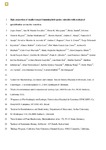High proportion of smaller ranged hummingbird species coincides with ecological specialization across the Americas
| dc.contributor.author | Sonne, Jesper | |
| dc.contributor.author | Martín González, AM | |
| dc.contributor.author | Maruyama, PK | |
| dc.contributor.author | Sandel, B | |
| dc.contributor.author | Vizentin-Bugoni, J | |
| dc.contributor.author | Schleuning, M | |
| dc.contributor.author | Abrahamczyk, S | |
| dc.contributor.author | Alarcón, R | |
| dc.contributor.author | Araujo, AC | |
| dc.contributor.author | Araújo, FP | |
| dc.contributor.author | Mendes de Azevedo, S | |
| dc.contributor.author | Baquero, AC | |
| dc.contributor.author | Cotton, Peter | |
| dc.contributor.author | Ingversen, TT | |
| dc.contributor.author | Kohler, G | |
| dc.contributor.author | Lara, C | |
| dc.contributor.author | Guedes Las-Casas, FM | |
| dc.contributor.author | Machado, AO | |
| dc.contributor.author | Machado, CG | |
| dc.contributor.author | Maglianesi, MA | |
| dc.contributor.author | Moura, AC | |
| dc.contributor.author | Nogués-Bravo, D | |
| dc.contributor.author | Oliveira, GM | |
| dc.contributor.author | Oliveira, PE | |
| dc.contributor.author | Ornelas, JF | |
| dc.contributor.author | Rodrigues, LDC | |
| dc.contributor.author | Rosero-Lasprilla, L | |
| dc.contributor.author | Rui, AM | |
| dc.contributor.author | Sazima, M | |
| dc.contributor.author | Timmermann, A | |
| dc.contributor.author | Varassin, IG | |
| dc.contributor.author | Wang, Z | |
| dc.contributor.author | Watts, S | |
| dc.contributor.author | Fjeldså, J | |
| dc.contributor.author | Svenning, J-C | |
| dc.contributor.author | Rahbek, C | |
| dc.contributor.author | Dalsgaard, B | |
| dc.date.accessioned | 2016-05-18T14:22:54Z | |
| dc.date.accessioned | 2017-07-17T13:20:27Z | |
| dc.date.accessioned | 2017-07-17T13:30:34Z | |
| dc.date.available | 2016-05-18T14:22:54Z | |
| dc.date.available | 2017-07-17T13:20:27Z | |
| dc.date.available | 2017-07-17T13:30:34Z | |
| dc.date.issued | 2016-02-10 | |
| dc.identifier.issn | 0962-8452 | |
| dc.identifier.issn | 1471-2954 | |
| dc.identifier.other | ARTN 20152512 | |
| dc.identifier.uri | http://hdl.handle.net/10026.1/9626 | |
| dc.description.abstract |
<jats:p> Ecological communities that experience stable climate conditions have been speculated to preserve more specialized interspecific associations and have higher proportions of smaller ranged species (SRS). Thus, areas with disproportionally large numbers of SRS are expected to coincide geographically with a high degree of community-level ecological specialization, but this suggestion remains poorly supported with empirical evidence. Here, we analysed data for hummingbird resource specialization, range size, contemporary climate, and Late Quaternary climate stability for 46 hummingbird–plant mutualistic networks distributed across the Americas, representing 130 hummingbird species ( <jats:italic>ca</jats:italic> 40% of all hummingbird species). We demonstrate a positive relationship between the proportion of <jats:italic>SRS of hummingbirds</jats:italic> and community-level specialization, i.e. the division of the floral niche among coexisting hummingbird species. This relationship remained strong even when accounting for climate, furthermore, the effect of SRS on specialization was far stronger than the effect of specialization on SRS, suggesting that climate largely influences specialization through species' range-size dynamics. Irrespective of the exact mechanism involved, our results indicate that communities consisting of higher proportions of SRS may be vulnerable to disturbance not only because of their small geographical ranges, but also because of their high degree of specialization. </jats:p> | |
| dc.format.extent | 20152512-20152512 | |
| dc.format.medium | ||
| dc.language | en | |
| dc.language.iso | eng | |
| dc.publisher | The Royal Society | |
| dc.relation.replaces | http://hdl.handle.net/10026.1/4655 | |
| dc.relation.replaces | 10026.1/4655 | |
| dc.relation.replaces | http://hdl.handle.net/10026.1/9625 | |
| dc.relation.replaces | 10026.1/9625 | |
| dc.subject | biogeography | |
| dc.subject | climate gradients | |
| dc.subject | macroecology | |
| dc.subject | mutualistic networks | |
| dc.subject | range size | |
| dc.subject | specialization | |
| dc.title | High proportion of smaller ranged hummingbird species coincides with ecological specialization across the Americas | |
| dc.type | journal-article | |
| dc.type | Journal Article | |
| dc.type | Research Support, Non-U.S. Gov't | |
| plymouth.author-url | https://www.webofscience.com/api/gateway?GWVersion=2&SrcApp=PARTNER_APP&SrcAuth=LinksAMR&KeyUT=WOS:000369975500011&DestLinkType=FullRecord&DestApp=ALL_WOS&UsrCustomerID=11bb513d99f797142bcfeffcc58ea008 | |
| plymouth.issue | 1824 | |
| plymouth.volume | 283 | |
| plymouth.publication-status | Published | |
| plymouth.journal | Proceedings of the Royal Society B: Biological Sciences | |
| dc.identifier.doi | 10.1098/rspb.2015.2512 | |
| plymouth.organisational-group | /Plymouth | |
| plymouth.organisational-group | /Plymouth/Faculty of Science and Engineering | |
| plymouth.organisational-group | /Plymouth/Faculty of Science and Engineering/School of Biological and Marine Sciences | |
| plymouth.organisational-group | /Plymouth/REF 2021 Researchers by UoA | |
| plymouth.organisational-group | /Plymouth/REF 2021 Researchers by UoA/UoA06 Agriculture, Veterinary and Food Science | |
| plymouth.organisational-group | /Plymouth/Research Groups | |
| plymouth.organisational-group | /Plymouth/Research Groups/Marine Institute | |
| plymouth.organisational-group | /Plymouth/Users by role | |
| plymouth.organisational-group | /Plymouth/Users by role/Academics | |
| dc.publisher.place | England | |
| dc.rights.embargodate | 2017-02-10 | |
| dc.identifier.eissn | 1471-2954 | |
| dc.rights.embargoperiod | 12 months | |
| rioxxterms.versionofrecord | 10.1098/rspb.2015.2512 | |
| rioxxterms.licenseref.uri | http://www.rioxx.net/licenses/under-embargo-all-rights-reserved | |
| rioxxterms.type | Journal Article/Review |


